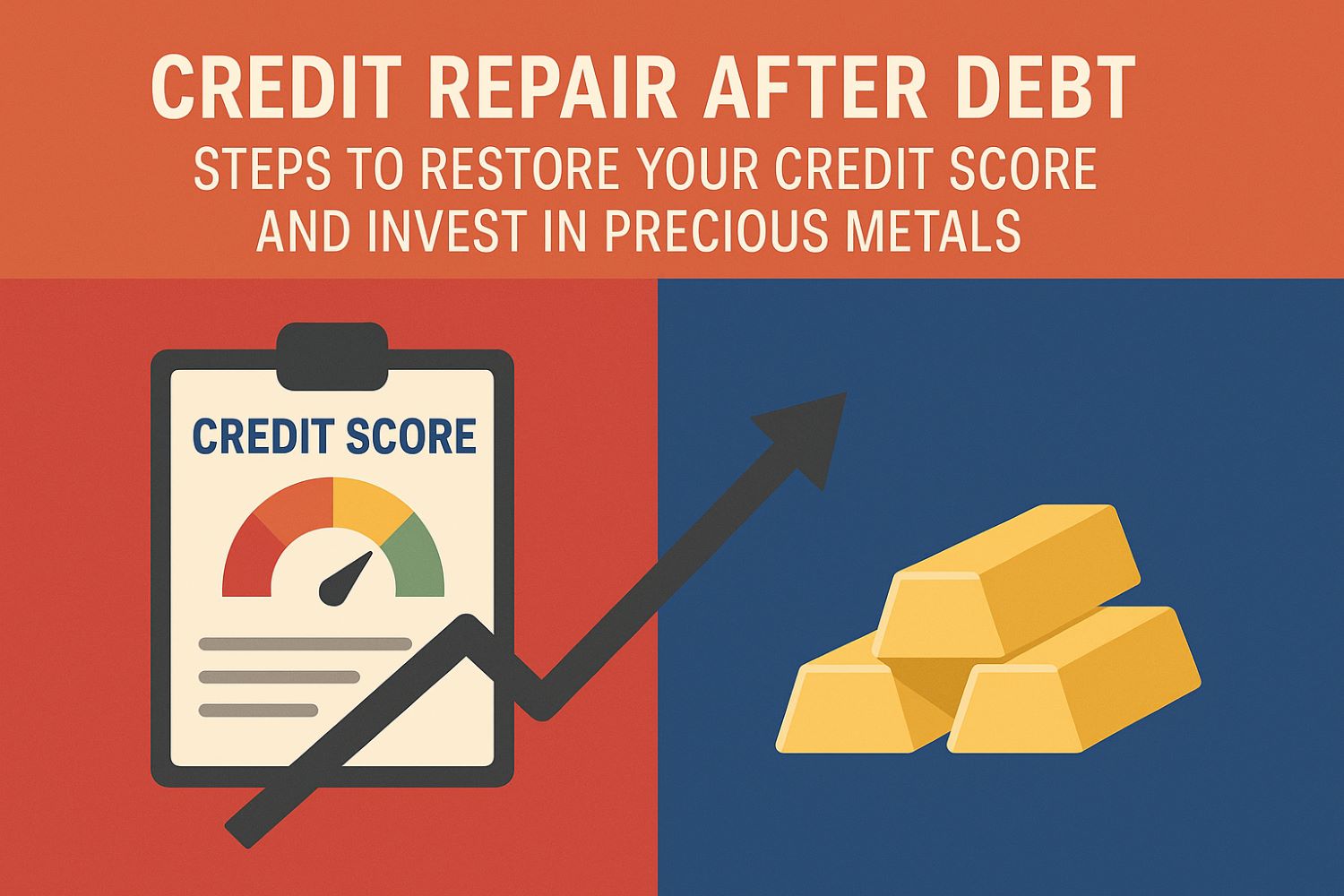Emerging from debt is more than just a financial relief—it’s an opportunity for a fresh start. If you’ve recently completed a debt settlement program or paid off significant obligations, now is the perfect time to think beyond recovery and toward long-term stability. A key part of that next step? Protecting your hard-earned savings with assets that are resilient in uncertain times, like physical gold.
This article explores how to navigate credit repair after debt and why this transitional period is ideal for exploring wealth-preserving strategies like precious metals IRAs.
Table of Contents
- 1 Step One: Start the Credit Repair Process
- 2 ✅ 1. Check Your Credit Reports
- 3 ✅ 2. Make On-Time Payments Going Forward
- 4 ✅ 3. Avoid Opening New Lines of High-Risk Credit
- 5 Why Credit Repair Alone Isn’t Enough
- 6 Step Two: Shift Focus from Borrowing to Protecting
- 7 ✅ Intrinsic Value
- 8 ✅ Inflation Hedge
- 9 ✅ Portfolio Diversification
- 10 Why Retirement-Aged Investors Are Turning to Precious Metals Now
- 11 Step Three: Consider a Precious Metals IRA (Gold IRA)
- 12 🔁 Eligible Accounts for Rollovers:
- 13 Benefits of a Gold IRA During the Credit Recovery Phase
- 14 Step Four: Choose a Reputable Gold IRA Company
- 15 Conclusion: Repair Credit, Then Protect Wealth
Step One: Start the Credit Repair Process
After debt resolution, your credit report might reflect late payments, high credit utilization, or settled accounts. While this is common, your score isn’t stuck—it’s just in recovery mode. Here are a few practical steps to begin rebuilding:
✅ 1. Check Your Credit Reports
Request free copies of your credit reports from all three bureaus at AnnualCreditReport.com. Look for:
- Closed accounts
- Incorrect balances
- Duplicate entries
- Late payments that shouldn’t be there
Dispute any errors to get your report back on track.
✅ 2. Make On-Time Payments Going Forward
Payment history makes up 35% of your FICO score. Whether it’s a mortgage, car loan, or utilities- stay current. If you have active credit cards, keep your balances low and pay at least the minimums.
✅ 3. Avoid Opening New Lines of High-Risk Credit
Now isn’t the time for flashy credit card offers. Focus on existing accounts and let your profile season. The longer you manage credit responsibly, the more your score will recover.
Why Credit Repair Alone Isn’t Enough
While rebuilding credit is critical, it only tells part of the financial story, especially for those nearing retirement. Credit scores measure your ability to borrow; they don’t reflect how well your assets are protected or diversified.
That’s where physical assets like gold come in.
Step Two: Shift Focus from Borrowing to Protecting
After years of managing debt and rebuilding your credit profile, you want to avoid falling back into financial vulnerability. One of the best ways to do that is to safeguard your savings against market volatility, inflation, and economic downturns.
Gold and other precious metals offer an age-old solution:
✅ Intrinsic Value
Unlike fiat currency, gold holds tangible, universally recognized value. It isn’t tied to any single government or central bank.
✅ Inflation Hedge
When the dollar weakens or inflation rises, gold typically holds its purchasing power.
✅ Portfolio Diversification
Gold doesn’t move in tandem with stocks or bonds, which means it can act as a stabilizing force in your retirement portfolio.
Why Retirement-Aged Investors Are Turning to Precious Metals Now
Many Americans aged 55 and older are worried about retirement savings lasting through a long retirement, especially in an environment of:
- High inflation eating away at purchasing power
- Stock market volatility driven by global tensions
- Uncertain tax policies that could affect future retirement income
Precious metals—particularly Gold IRAs—have emerged as a smart option for those looking to preserve wealth, diversify retirement assets, and reduce exposure to systemic risk.
Step Three: Consider a Precious Metals IRA (Gold IRA)
A Gold IRA is a type of self-directed individual retirement account that allows you to hold physical gold (and other IRS-approved precious metals) in a tax-advantaged structure.
🔁 Eligible Accounts for Rollovers:
- Traditional IRAs
- 401(k), 403(b), 457 plans
- Thrift Savings Plans (TSP)
If you’re no longer employed by the company that manages your retirement plan, you may be eligible for a tax-free rollover into a Gold IRA.
Benefits of a Gold IRA During the Credit Recovery Phase
Now that you’re rebuilding your financial life, a Gold IRA can help anchor your strategy:
- Reduces Reliance on Risky Markets: You’ve already faced volatility through debt—now is the time to minimize it.
- No Need for Borrowing or Leveraging: A Gold IRA works with your existing retirement savings.
- Peace of Mind: Physical metals can’t be hacked, printed, or inflated away.
And best of all? You’re in control. With a self-directed IRA, you choose the metals, custodian, and storage strategy that fit your goals.
Step Four: Choose a Reputable Gold IRA Company
Selecting a trustworthy provider is key. Look for these signs:
- ✅ Transparent fee structure
- ✅ IRS-compliant custodians and depositories
- ✅ Positive reviews and BBB accreditation
- ✅ Expert guidance for first-time investors
Some of the top-rated companies even offer free Gold IRA guides, one-on-one consultations, and tailored rollover assistance for retirees.
Conclusion: Repair Credit, Then Protect Wealth
Rebuilding credit after debt is a powerful milestone, especially for those approaching retirement. But it’s only one part of the larger financial puzzle.
Once your credit is improving, it’s time to pivot from risk recovery to asset protection. That’s where gold—and other physical precious metals—can play an essential role. A Gold IRA provides a safe, tax-advantaged way to guard your savings against future uncertainty so that you can retire with greater confidence.


